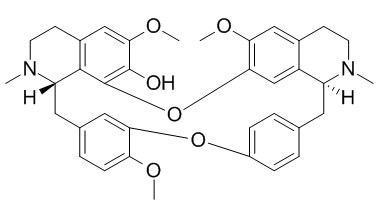Fangchinoline
| Catalog No. |
CFN99167 |
 |
| CAS No. |
436-77-1 |
| Molecular Weight: |
608.71 |
| Molecular Formula |
C37H40N2O6 |
| DBs |
[PubChem]:274951251
[ChEMBL]:25306
[PCIDB]: |
Standard InChI:
InChI=1S/C37H40N2O6/c1-38-14-12-24-19-31(42-4)33-21-27(24)28(38)16-22-6-9-26(10-7-22)44-32-18-23(8-11-30(32)41-3)17-29-35-25(13-15-39(29)2)20-34(43-5)36(40)37(35)45-33/h6-11,18-21,28-29,40H,12-17H2,1-5H3/t28-,29-/m0/s1
Biological Activity
Fangchinoline and tetrandrine are the major alkaloids from Stephania tetrandrae S. they shows anti-inflammatory effects on mouse ear edema induced by croton oil, the biochemical mechanisms of fangchinoline and tetrandrine on anti-inflammation are significantly different even though they are similar in chemical structure.[1]
Fangchinoline and tetrandrine have vasodilating and hypotensive effects on the rat aorta and the stroke-prone spontaneously hypertensive rat.[2]
Fangchinoline is a highly specific agent inducing autophagic cell death via p53/sestrin2/AMPK signalling in hepatocellular carcinoma cells with a novel mechanism, which elucidates the potential of fangchinoline to potentiate programmed cell death in cancer cells.[3]
Fangchinoline is a nonspecific Ca(2+) channel blocker, it reduces both FBS- and PDGF-BB-induced RASMCs proliferation by perturbing cell cycle progression; this antiproliferative effect of FAN is dependent on the MAP kinase pathway, but cannot be limited to its Ca(2+) modulation.[4]
Fangchinoline (Fan) has anti-tumorigenic activity in vivo, including reduction of tumor volume and pro-apoptotic and anti-proliferative effects in a PC3 nude mouse xenograft, it inhibits human prostate cancer cell lines (PC3) cell proliferation in a dose- and time-dependent manner, the anti-proliferative effect is associated with an increase in the G1/S phase of PC3 cells, suggests that Fan is an effective anti-proliferative agent that modulates cell growth regulators in prostate cancer cells.[5]
Fangchinoline can enhance the cytotoxicity of multidrug resistance-related drugs via modulation of P-glycoprotein.[6]
Fangchinoline has effective antioxidant and radical scavenging activity, also has protective effects on hydrogen peroxide-induced oxidative neuronal cell damage in cultured rat cerebellar granule cells.[7]
Fangchinoline can inhibit human immunodeficiency virus type 1 replication by interfering with gp160 proteolytic processing.[8]
Product
References
[1] Choi H S, Kim H S, Min K R, et al. J Ethnopharmacol, 2000, 69(2):173-9.
[2] Kim H S, Zhang Y H, Oh K W, et al. J Ethnopharmacol, 1997, 58(2):117-23.
[3] Ning Wang †, Weidong Pan †, Zhu M, et al. Brit J Pharmacol, 2011, 164(2b):731–42.
[4] Zhang Y H, Fang L H, Ku B S. Biochem Pharmacol, 2003, 66(9):1853-60.
[5] Choi S U, Park S H, Kim K H, et al. Anti-cancer drugs, 1998, 9(3):255-61.
[6] Wang CD, Huang JG, Gao X, et al.Biosci Biotech Bioch, 2010, 74(3):488-93.
[7] Gülçin I, Elias R, Gepdiremen A, et al. J Enzyme Inhib Med Ch, 2010, 25(25):44-53.
[8] Koh S B, Ban J Y, Lee B Y, et al. Planta Med, 2003, 69(6):506-12.
[9] Wan Z, Lu Y, Liao Q, et al. Plos One, 2012, 7(6):286-286.
Lu X G, Zhang R X, Feng F, et al. J Chromatogr Sci, 2015, 53(8):1-5.






